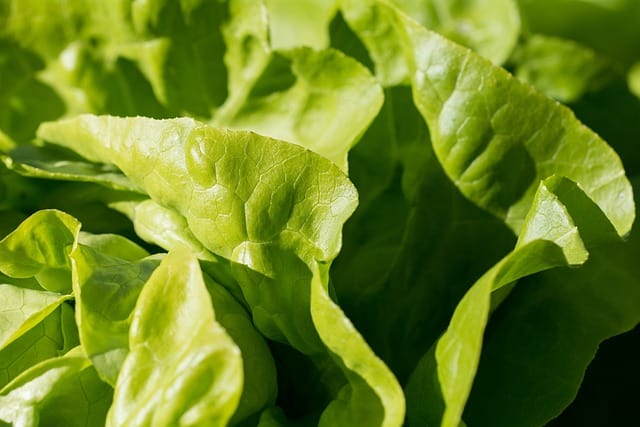Brown spots on lettuce leaves can be a common sight in many households. While they may not look very appetizing, the good news is that these spots do not necessarily mean that the lettuce has gone bad. In fact, with a little bit of effort, it is possible to salvage the lettuce and make it safe to eat.
Understanding brown spots on lettuce leaves is the first step towards identifying the causes and taking appropriate measures to prevent them. In general, these spots are caused by a number of factors such as physical damage, environmental factors, and diseases.
Physical damage can occur during harvesting, transportation, or storage. Environmental factors such as high humidity, temperature fluctuations, and exposure to ethylene gas can also cause brown spots on lettuce leaves. Additionally, diseases such as bacterial leaf spot and downy mildew can also cause discoloration on lettuce leaves.
To prevent brown spots on lettuce leaves, it is important to take appropriate measures during planting and growing conditions. This includes ensuring proper irrigation, fertilization, and pest control.
Additionally, it is important to store lettuce properly and avoid exposure to ethylene gas. By understanding the causes of brown spots on lettuce leaves and taking appropriate measures, it is possible to enjoy fresh and healthy lettuce without any discoloration or damage.
Key Takeaways
- Brown spots on lettuce leaves are caused by physical damage, environmental factors, and diseases.
- Proper planting and growing conditions, irrigation, fertilization, and pest control can help prevent brown spots on lettuce leaves.
- Storing lettuce properly and avoiding exposure to ethylene gas can also help prevent brown spots on lettuce leaves.
Also read:
- Brown Spots on Leaves Pothos
- Brown Spots on Leaves of Peace Lily
- Brown Spots on Leaves of Fiddle Leaf Fig
Understanding Brown Spots on Lettuce Leaves
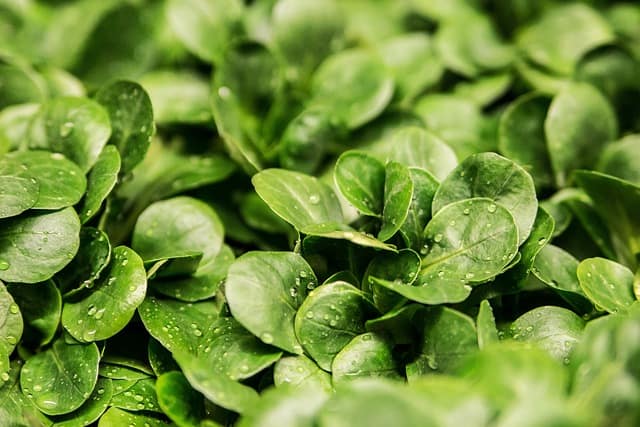
Brown spots on lettuce leaves can be a common problem for gardeners and farmers. These spots can appear on the outer leaves, inner leaves, or even the stem of the lettuce plant. The spots can vary in size and shape, and they can be caused by several factors.
One of the most common causes of brown spots on lettuce leaves is bacterial leaf spot. This is a bacterial disease that can affect a wide range of plants, including lettuce.
The disease is caused by the Xanthomonas campestris bacterium, which can be spread by water, wind, or insects. The symptoms of bacterial leaf spot include small, water-soaked spots that turn brown and eventually black. These spots can merge together to form larger lesions.
Another cause of brown spots on lettuce leaves is fungal diseases. One such disease is cercospora leaf spot, which is caused by the Cercospora fungus. This disease can cause small, tan to brown lesions on the leaves, which are surrounded by a reddish-purple border.
Eventually, the center of the lesion may drop out, leaving a hole. Older infected leaves may yellow and die.
Environmental factors can also cause brown spots on lettuce leaves. For example, if the lettuce plant is exposed to high levels of sunlight or heat, it can cause the leaves to develop brown spots. Similarly, if the plant is exposed to too much moisture, it can cause the development of rust on the leaves, which can appear as brown spots.
Brown Spots on Lettuce Leaves – 4 Common Problems
Lettuce is a popular leafy vegetable that is used in a variety of dishes. However, brown spots on lettuce leaves can be unsightly and may indicate a problem with the plant. There are several causes of brown spots on lettuce leaves, including fungal diseases, bacterial leaf spot, russet spotting, and mosaic virus.
1. Fungal Diseases

Fungal diseases are a common cause of brown spots on lettuce leaves. These diseases are caused by various types of fungi that can infect the leaves, stems, and roots of the plant. Some of the most common fungal diseases that affect lettuce include downy mildew, powdery mildew, and gray mold.
Downy mildew is characterized by yellow or brown spots on the upper surface of the leaves and a fuzzy white growth on the underside of the leaves. Powdery mildew appears as a white or gray powdery coating on the leaves. Gray mold causes brown spots on the leaves that may be surrounded by a grayish mold.
2. Bacterial Leaf Spot
Bacterial leaf spot is another common cause of brown spots on lettuce leaves. This disease is caused by the Xanthomonas campestris bacterium and can infect the leaves, stems, and seeds of the plant.
The main symptom of bacterial leaf spot is black lesions on the outer leaves, often surrounded by yellow discoloration known as halo spots.
3. Russet Spotting
Russet spotting is a condition that affects lettuce plants and causes brown, rust-colored spots on the leaves. This condition is caused by an excess of moisture during the storage process.
The reddish-brown stuff that appears on your lettuce, often near the root, is what most professional chefs refer to as “rust.” It’s a pretty apt name once you think about it.
4. Mosaic Virus
Mosaic virus is a viral disease that affects lettuce plants and causes brown spots on the leaves. This virus is transmitted by aphids and other insects and can also be spread by contaminated tools and equipment. The main symptom of mosaic virus is a mottled or mosaic-like pattern on the leaves.
Role of Environmental Factors
Environmental factors play a critical role in the development and severity of brown spots on lettuce leaves. The following sub-sections explore how water and moisture, sunlight, and airflow can affect the health of lettuce plants.
1. Water and Moisture

Lettuce plants require adequate moisture to grow and thrive. However, excessive moisture can create conditions that are favorable for the growth of bacteria and fungi. Overhead watering, in particular, can lead to the development of brown spots on lettuce leaves.
This is because water droplets on the leaves can act as a magnifying glass, intensifying the sun’s rays and causing sunburn, which can lead to brown spots. Additionally, high humidity levels can create a moist environment that encourages the growth of fungal pathogens.
2. Sunlight
Sunlight plays a crucial role in the growth and development of lettuce plants. However, excessive exposure to direct sunlight can lead to the development of brown spots on lettuce leaves.
This is because the sun’s rays can cause sunburn, which can damage the cells in the leaves and lead to the development of brown spots. Additionally, plants that are grown in areas with intense sunlight may require more water to prevent dehydration, which can lead to the development of brown spots.
3. Airflow
Airflow is essential for the growth and development of lettuce plants. Good airflow can help to prevent the buildup of moisture on the leaves, which can create conditions that are favorable for the growth of bacterial and fungal pathogens.
Additionally, good airflow can help to prevent the development of brown spots by reducing the amount of time that water droplets remain on the leaves. Plants that are grown in areas with poor airflow may be more susceptible to the development of brown spots.
Lettuce Planting and Growing Conditions
1. Soil and Fertilizer
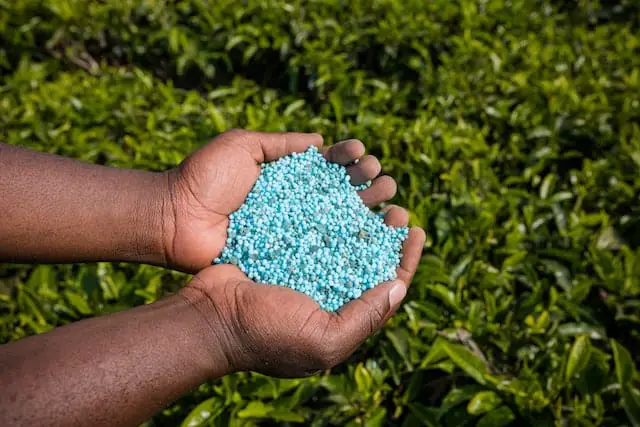
Lettuce thrives in well-draining soil that is moist but not waterlogged. The soil should be rich in organic matter and have a pH level between 6.0 and 7.0. Before planting, it is recommended to amend the soil with compost or well-rotted manure to improve its structure and fertility.
When it comes to fertilizer, it is important not to overdo it. Too much nitrogen can lead to excessive leaf growth and delay the head formation. A balanced fertilizer with an NPK ratio of 10-10-10 or 5-10-10 can be applied before planting or during the growing season.
Alternatively, a slow-release fertilizer can be used to provide a steady supply of nutrients over a longer period.
2. Spacing and Planning
Proper spacing is crucial for healthy lettuce plants. Crowded plants are more susceptible to disease and pests, and they compete for nutrients and water. The recommended spacing for lettuce depends on the variety and the growing conditions.
In general, leaf lettuce can be planted 4 to 6 inches apart, while head lettuce requires more space, about 12 to 18 inches apart.
When planning the lettuce garden, it is important to consider the growing season and the temperature requirements of the variety. Lettuce prefers cool weather and can tolerate light frost, but it does not thrive in hot and humid conditions.
Planting lettuce in the spring or fall, when the temperature is between 45°F and 75°F, is ideal for most varieties.
3. Proper Use of Compost
Compost is a valuable source of organic matter and nutrients for lettuce plants. It improves soil structure, increases water retention, and promotes beneficial microorganisms. However, it is important to use compost properly to avoid problems.
Compost should be well-rotted and free of weed seeds and pathogens. It should be applied to the soil surface as a mulch or worked into the top few inches of soil before planting. It is not recommended to use fresh or partially decomposed compost, as it can rob the soil of nitrogen and cause nitrogen deficiency in the plants.
By following these guidelines for soil, fertilizer, spacing, planning, and compost use, lettuce growers can create optimal growing conditions for their plants and reduce the risk of brown spots and other problems.
Effects of Ethylene Gas
Ethylene gas is a naturally occurring plant hormone that plays a crucial role in the ripening and aging of fruits and vegetables. It is also responsible for the development of brown spots on lettuce leaves. When lettuce is exposed to ethylene gas, it triggers a chemical reaction that leads to the production of brown spots on the leaves.
While ethylene gas is not harmful to humans, it can be very damaging to certain vegetables, including lettuce. In addition to producing brown spots on lettuce ribs, it takes away the green in many leafy greens, softens the skins of summer squash, and causes some root vegetables, such as carrots, to become bitter.
Ethylene gas is produced naturally by many fruits and vegetables, including apples, bananas, and avocados. It is also produced during the combustion of fossil fuels and by certain industrial processes.
Exposure to ethylene gas can be controlled by storing ethylene-releasing produce, like apples, bananas, and avocados, away from lettuce. However, sometimes the exposure is out of control, such as during the delivery of produce.
It is important to note that not all brown spots on lettuce are caused by ethylene gas exposure. Lettuce leaves can also turn brown when they have been bruised or cut because exposure to air triggers oxidation.
Additionally, brown spots can be a sign of disease or pest damage. It is important to inspect lettuce carefully before consuming it to ensure that it is safe to eat.
Common Lettuce Diseases
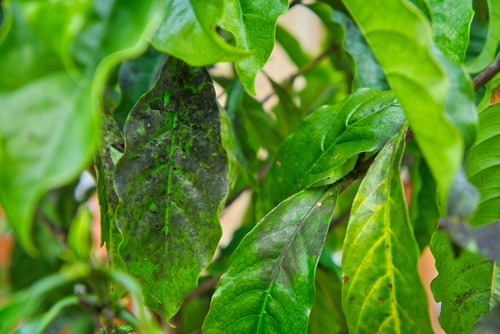
Lettuce is a popular salad green that is grown in many parts of the world. However, it is prone to several diseases that can affect its growth and yield. In this section, we will discuss two of the most common lettuce diseases: damping off and fungal disease.
Damping Off
Damping off is a fungal disease that affects young seedlings of lettuce. It is caused by several species of fungi, including Rhizoctonia solani, Pythium spp., and Fusarium spp.
The disease is characterized by the sudden collapse of the seedling at the soil line. The affected seedlings may also have a water-soaked appearance and may be covered with a white or grayish mold.
Damping off can be prevented by using sterilized soil, avoiding overwatering, and providing good air circulation. If the disease has already affected the seedlings, they should be removed and destroyed to prevent the spread of the disease.
Fungal Disease
Fungal diseases are common in lettuce and can affect both the leaves and the roots of the plant. Some of the most common fungal diseases that affect lettuce include downy mildew, powdery mildew, and gray mold.
Downy mildew is caused by the fungus Bremia lactucae and is characterized by yellowing and wilting of the leaves. The affected leaves may also have a grayish mold on the underside.
Powdery mildew is caused by several species of fungi and is characterized by a white or grayish powdery growth on the leaves. Gray mold is caused by the fungus Botrytis cinerea and is characterized by brownish spots on the leaves and a grayish mold on the affected areas.
Fungal diseases can be prevented by providing good air circulation, avoiding overwatering, and removing any infected plant material. Fungicides can also be used to control the spread of the disease.
Lettuce Pests and Herbivores
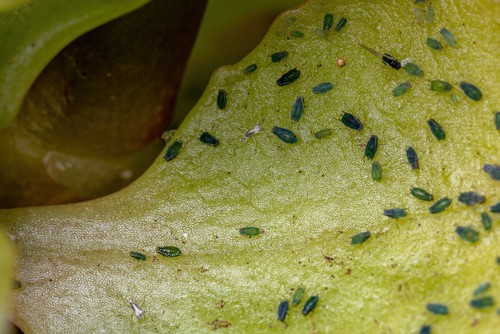
Lettuce is a favorite among many pests and herbivores, making it a challenge to grow without protection. Here are some of the most common pests and herbivores that can cause brown spots on lettuce leaves.
1. Aphids
Aphids are tiny, soft-bodied insects that suck sap from lettuce leaves. They are usually found on the undersides of leaves and can cause brown spots on the leaves. Aphids can also transmit viruses to lettuce plants.
To control aphids, use insecticidal soap or neem oil. You can also introduce natural predators like ladybugs or lacewings to your garden.
2. Fungus Gnats
Fungus gnats are small, black flies that can cause brown spots on lettuce leaves. They lay their eggs in damp soil and the larvae feed on the roots of lettuce plants. This can cause the leaves to turn brown and wilt.
To control fungus gnats, allow the soil to dry out slightly between waterings. You can also use yellow sticky traps to catch the adult flies.
3. Rabbits
Rabbits are herbivores that love to eat lettuce. They can cause brown spots on lettuce leaves by chewing on them. Rabbits are especially problematic in the spring when lettuce is young and tender.
To protect lettuce from rabbits, use a physical barrier like a fence or row cover. You can also plant lettuce in containers or raised beds that are out of reach of rabbits.
4. Deer
Deer are another herbivore that can cause brown spots on lettuce leaves. They can strip a lettuce plant of its leaves in a matter of minutes. Deer are most active at dawn and dusk, so it’s important to protect lettuce plants during these times.
To protect lettuce from deer, use a physical barrier like a fence or row cover. You can also use deer repellents like human hair or predator urine.
Susceptible Crops
Lettuce is not the only crop that is susceptible to brown spots. Several other crops are also prone to this problem. In this section, we will discuss some of the crops that are susceptible to brown spots and what you can do to prevent them.
1. Spinach

Spinach is another leafy green that is susceptible to brown spots. The most common cause of brown spots on spinach leaves is a fungal disease called leaf spot. This disease is caused by the fungus Cercospora beticola.
The fungus infects the leaves of the spinach plant, causing brown spots to form. Over time, the spots can grow and merge, causing the leaves to turn yellow and die.
To prevent leaf spot on spinach, it is important to practice good crop rotation. Do not plant spinach in the same spot for at least three years. Also, make sure to keep the area around the plants free of debris and weeds. Finally, water the plants at the base rather than from above to prevent the leaves from getting wet.
2. Beet
Beet leaves are also susceptible to brown spots. The most common cause of brown spots on beet leaves is a fungal disease called Cercospora leaf spot. This disease is caused by the fungus Cercospora beticola, the same fungus that causes leaf spot on spinach.
To prevent Cercospora leaf spot on beets, it is important to practice good crop rotation. Do not plant beets in the same spot for at least three years. Also, make sure to keep the area around the plants free of debris and weeds. Finally, water the plants at the base rather than from above to prevent the leaves from getting wet.
3. Pepper
Pepper leaves can also develop brown spots. The most common cause of brown spots on pepper leaves is bacterial leaf spot. This disease is caused by the bacterium Xanthomonas campestris.
The bacteria infect the leaves of the pepper plant, causing brown spots to form. Over time, the spots can grow and merge, causing the leaves to turn yellow and die.
To prevent bacterial leaf spot on peppers, it is important to practice good sanitation. Make sure to remove any infected plants and debris from the garden. Also, avoid overhead watering, as this can spread the bacteria. Finally, practice good crop rotation, and do not plant peppers in the same spot for at least three years.
4. Bean
Bean leaves can also develop brown spots. The most common cause of brown spots on bean leaves is a fungal disease called anthracnose. This disease is caused by the fungus Colletotrichum lindemuthianum.
The fungus infects the leaves of the bean plant, causing brown spots to form. Over time, the spots can grow and merge, causing the leaves to turn yellow and die.
To prevent anthracnose on beans, it is important to practice good sanitation. Make sure to remove any infected plants and debris from the garden. Also, avoid overhead watering, as this can spread the fungus. Finally, practice good crop rotation, and do not plant beans in the same spot for at least three years.
Prevention and Control Measures

Preventing the development of brown spots on lettuce leaves is the best way to avoid the spread of diseases. Here are some measures that can be taken to prevent and control brown spots on lettuce leaves:
- Use pathogen-free seed: Using pathogen-free seed is the first step in disease management. However, reliable seed assays and established threshold levels are not yet available.
- Avoid overhead irrigation: Overhead irrigation can splash water onto the leaves, increasing the risk of bacterial and fungal infections. Drip irrigation or soaker hoses are recommended instead.
- Remove infected leaves: Any affected leaves should be removed on sight and disposed of in the trash, or far away from other plants or garden soil. This will prevent the spread of the disease to healthy leaves.
- Apply mulch: Applying mulch around the base of the lettuce plants can help prevent soil-borne diseases from splashing onto the leaves during watering or rainfall.
- Practice crop rotation: Crop rotation is an effective way to prevent the buildup of soil-borne diseases. Rotate lettuce with other crops such as tomatoes or peppers to prevent disease buildup in the soil.
- Apply copper fungicide: Copper fungicide can be used sparingly to prevent the spread of fungal diseases. However, overuse can reduce its efficacy. Bonide Copper Fungicide is a good option that can be found in 16- or 32-ounce ready-to-spray bottles.
- Maintain clean gardening tools: Keeping gardening tools clean and free of soil and debris can help prevent the spread of disease from one plant to another.
By following these prevention and control measures, gardeners can reduce the risk of brown spots on lettuce leaves and keep their plants healthy and productive.
Frequently Asked Questions
Is it safe to eat iceberg lettuce with brown spots?
Yes, it is generally safe to eat iceberg lettuce with brown spots. Brown spots on lettuce leaves are usually caused by a fungus or bacteria, but they do not necessarily indicate that the lettuce is spoiled or unsafe to eat.
However, it is always a good idea to inspect your lettuce carefully before eating it, and to discard any leaves that look slimy, moldy, or have a strong odor.
Why does lettuce turn brown in the refrigerator?
Lettuce can turn brown in the refrigerator due to a variety of reasons, including exposure to moisture, temperature fluctuations, and exposure to ethylene gas.
To prevent brown spots on lettuce leaves, it is important to store lettuce in a dry, cool place, such as a crisper drawer in the refrigerator. It is also a good idea to wrap lettuce in paper towels or a clean cloth to absorb excess moisture.
How do you get rid of brown spots on lettuce?
To get rid of brown spots on lettuce, you can try washing the leaves in cold water and patting them dry with a clean towel.
If the brown spots persist, you can try trimming off the affected areas with a sharp knife or kitchen scissors. However, if the brown spots are caused by a fungus or bacteria, it may be best to discard the affected leaves entirely.
What is thea brown fungus on lettuce?
The brown fungus on lettuce is most likely a type of leaf spot disease, such as bacterial leaf spot or septoria leaf spot. These diseases are caused by bacteria or fungi that infect the leaves of lettuce plants, causing brown or black spots to appear on the leaves.
While these diseases do not usually affect the safety of the lettuce, they can cause the leaves to become unsightly and may reduce the yield of the plant.
What causes dark green spots on lettuce leaves?
Dark green spots on lettuce leaves may be caused by a variety of factors, including sunscald, nutrient deficiencies, or insect damage. In some cases, these spots may also be caused by fungal or bacterial infections.
To prevent dark green spots on lettuce leaves, it is important to provide the plant with adequate nutrients and water, and to protect it from extreme temperatures and insect pests.
What are the tiny black spots on lettuce?
Tiny black spots on lettuce leaves may be caused by a variety of factors, including thrips, aphids, or fungal infections. These spots are usually not harmful to humans, but they can reduce the quality and yield of the lettuce plant.
To prevent tiny black spots on lettuce leaves, it is important to inspect the plant regularly for signs of insect damage or fungal infections, and to take appropriate measures to control these pests.

Hey, I’m Lisa and I’ve been an avid gardener for over 30 years. I love writing, talking and living in the garden! Feel free to connect with me on my socials below

